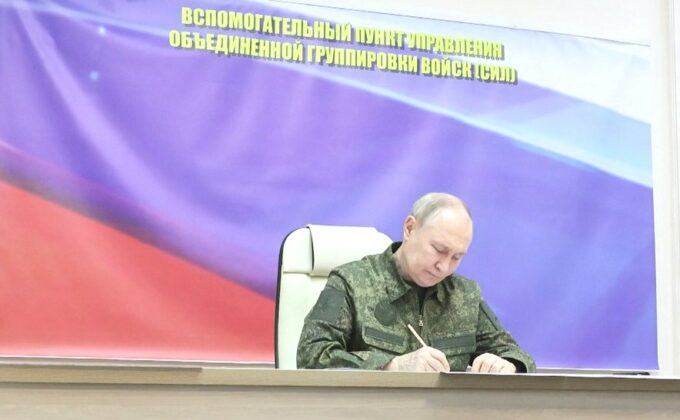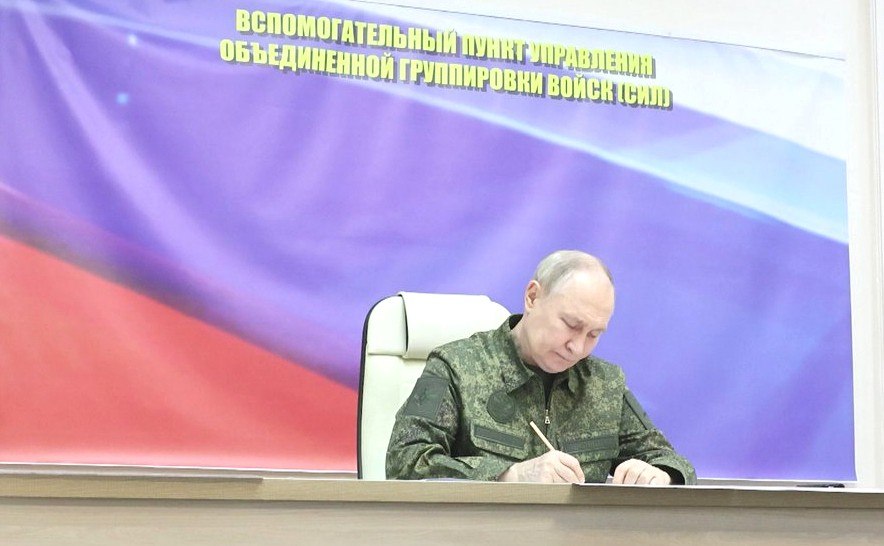






























































Photograph Source: Kremlin.ru – CC BY 4.0
The conventional wisdom regarding Russian President Vladimir Putin’s war against Ukraine is universally accepted by retired generals and ambassadors; bipartisan majorities in the House and Senate; too many political scientists, and of course the ever obedient mainstream media. The conventional wisdom roughly dictates that Putin invaded Ukraine to overthrow the government and occupy the entire country, marking the first step to reach further into East Europe to return states such as Poland to the Russian orbit; and to recreate the Soviet empire.
This wisdom dictates that the only response to Putin’s putative empire-building is to isolate Moscow; increase sanctions; pursue the war as Ukraine’s benefactor; and provide more lethal military equipment to Kyiv. There is a belief that Ukraine can win the war as a result, as well as the argument that Ukraine must be victorious in order to preserve the “international legal order” and to give the “rule of law a chance in Russia.” This latter statement belongs to Yale Professor Timothy Snyder, who argues that Ukraine’s victory would “lift the threat of major war in Europe…and Asia.”
Retired generals such as Wesley Clark and retired ambassadors such as Bill Taylor argue that the Trump administration “needs to push Putin hard to end the war in Ukraine—now.” The fact that sanctions have had no impact on Putin’s decision making, and that Russia has huge advantages in terms of strategic depth, greater numbers of personnel, more advanced offensive weaponry, and a willingness to use terrorist tactics against civilians and civilian infrastructure does not deter those who advocate applying greater force against the Russian military. These advocates favor a “decisive demonstration of political will” and greater “leverage of Western sanctions” to obtain a ceasefire and to “accelerate diplomacy.”
But what if these assumptions regarding the reasons for Putin’s war are wrong? If they are wrong, then the arguments for ways to get Putin to the bargaining table must be reexamined as must the concessions that the United States and the European members of NATO might have to entertain. For example, what if NATO expansion was a major factor in Putin’s decision to invade? What if Putin needs to have some security guarantees regarding the steady expansion of NATO that finds Russia’s western border virtually entirely encircled by NATO’s military forces? In that case, the United States would have to provide security guarantees not only to Ukraine, but also to Russia. Even if a ceasefire and an end to the war can be negotiated, there will be no peace in Europe as long as the current disposition of Western military force remains in place. Putin will not accept such a Western disposition of force on a permanent basis; no likely Russian leader would do so either.
It’s important to keep in mind that the expansion of NATO that began in the late 1990s was a betrayal that took advantage of Russia’s political and economic bankruptcy in the wake of the sudden and shocking collapse of the Soviet Union. President George H.W. Bush and Secretary of State James Baker assured their Soviet counterparts (Mikhail Gorbachev and Eduard Shevardnadze) that the United States would not “leap frog” over a reunified Germany if the Soviets were to remove their 380,000 troops from East Germany. Presidents Bill Clinton and George W. Bush destroyed this promise, and Bush Jr. was even willing to lobby the European members of NATO for Ukrainian and Georgian membership in an expanded NATO.
Serious critics of expansion, including former U.S. ambassadors to the Soviet Union (George Kennan and Jack Matlock) lobbied strongly against the expansion, but the Cold Warriors in U.S. administrations over the years have exaggerated the threat from the Soviet Union and Russia to this very day. This was true in the early years of the Cold War, when the Dulles brothers (John Foster and Allen), Frank Wisner, Paul Nitze, and others argued for greater defense spending to “contain” a Soviet threat. And it’s true in recent times, when the arguments for greater defense spending, which is now projected to exceed $1 trillion in the Trump era, cited the dual threat of Russia and China to lobby for unnecessary strategic modernization and greater power projection.
U.S. strategists and policymakers have always paraded behind the flag of greater support for the democratization of key East European countries, when the real purpose of U.S. diplomacy and deployment in Europe has been to maintain pressure on the Soviet Union and on Russia. As part of any reexamination of the threat perception regarding Russia, we must come to grips with easing the military pressure on Russia’s vulnerable western borders. Our regional missile defenses in Poland and Romania are unneeded, and the original justification for them as a defense against Iran’s missile program was risible. Our base framework in East Europe that includes regular force deployments in Poland and Bulgaria must be reassessed. The rotation of German forces in the Baltics is threatening to Russia, a country that lost 24 million citizens in WWII. The idea of Ukraine’s formal membership in NATO must be abandoned. After all, Ukraine in some ways is already an informal member of NATO, which includes secret aspects of military, technological and intelligence cooperation that is largely unknown to the general public….and even the Congress for that matter.
Finally, Putin would possibly be receptive to any serious discussion of the limits of Western military forces in East Europe because he has “already lost” the war in a strategic sense. In addition to the failure of his conventional attacks at the start of the war, the war itself has driven Ukraine to align itself with the West, has forced greater unity within NATO, and has led to increased defense spending throughout Europe. European unity has been enhanced with only the likes of Hungary, Slovenia, and Serbia showing varying degrees of support for Putin’s war. Most of NATO’s membership has agreed to greater defense spending, and even Germany—often willing to give Russia the benefit of the doubt—argues that Russia has become a greater threat. Even if Ukraine had to give up some territory in order to get an end to the war, a smaller Ukraine would remain a battle tested Ukraine with greater technological support from the West and would pose a greater threat to Russia as a result of having Europe’s largest standing army.
Even an infatuated Putin must now understand that Ukraine will never be part of Russia. However, as long as the high-level policy discussion in Washington cannot get beyond “Managing the Challenge of a Rogue Russia,” we will never get into a genuine return to diplomacy and dialogue with the Kremlin. The United States and Russia are now engaged in a huge increase in defense spending that neither one can afford. The prospects of a greater, longer, and more dangerous Cold War hang in the balance if we get this wrong.
At the risk of stating the obvious. it is not difficult to gauge the U.S. response if Russia and its arms and allies were to surround the United States.
The post What If the Conventional Wisdom About Putin’s War is Mostly Wrong? appeared first on CounterPunch.org.
This post was originally published on CounterPunch.org.